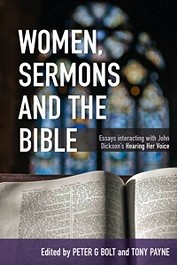Review: Women, Sermons and the Bible
Women, Sermons and the Bible: Essays interacting with John Dickson’s Hearing Her Voice
Edited by Peter G Bolt and Tony Payne
Matthias Media, Sydney, 2014, ebook
Women, Sermons and the Bible: Essays Interacting with John Dickson’s Hearing Her Voice (WSB) is an important contribution to the discussion concerning the appropriate context for the preaching ministry of women. The essays provide much valuable food for thought across a range of disciplines and areas of inquiry. As foreshadowed in the book’s subtitle, it certainly interacts with John Dickson’s Hearing Her Voice: A Case for Women Giving Sermons (HHV) but it ranges more broadly over issues of media and ministry, biblical and systematic theology, hermeneutics and exegetical study. Some of the essays only interact in passing with Dickson’s book, and seek to offer a ‘wide angle’ on the subject of the shared ministry of men and women in the Lord’s church. This is one of the book’s strengths.
John Dickson and the authors of WSB are all reformed evangelical Christians, ministering in the Anglican context (in Sydney, unlike your reviewer) and identifying as holding to a complementarian understanding of relationships between women and men in church life. The authors of both books agree that God in his wisdom and kindness has ordered relationships between the genders so that in the church there is an essential interdependence in ministry rather than an interchangeability. This complementarian approach affirms a God-glorifying ‘asymmetry’ between men and women, who, as equal sharers in the ‘gracious gift of life’, are appointed to serve in various and in some cases non-interchangeable contexts in accordance with, amongst other things, God’s good gift of gender. The final essay in WSB, by Mark Thompson, places the shape of the shared ministry of men and women in its ultimate theological context of the relations between the persons of the Trinity. This is a tremendously helpful and encouraging way to end the book, as it places this very particular and limited debate in its much wider context of the knowledge of God and the nature of our dignity and identity as creatures made in God’s image.
As self-professed complementarians, the authors of both books agree that the pastoral oversight of local fellowships of believers is a responsibility entrusted to men, and that godly and gifted women exercise word ministries of preaching and evangelism in many contexts. Both books affirm that there are many congregational speaking ministries open to women. Those responsible for planning Sunday gatherings do well to consider how women may encourage the meeting through spoken word. The disagreement is largely confined to whether it is consistent with 1 Timothy 2:12 for a woman to preach to a mixed gender gathering of God’s people—the usual form of ‘Sunday church’.
Dickson’s argument is that ‘teaching’, ‘prophesying’, and ‘exhortation’ are distinct activities in the New Testament.[1] The New Testament encourages women to exercise all these ministries in certain contexts but not in all contexts. 1 Timothy 2:12 prohibits women from teaching men. Dickson argues that the activity that Paul prohibits is to be understood specifically as “transmitting intact the new covenant words of the apostles”.[2] This is a particular form of authoritative speaking, “preserving and laying down the fixed traditions of and about Jesus as handed on by the apostles”, and cannot be the same as explaining or applying Scripture (although Dickson notes that it may involve these).[3] Dickson affirms a ‘spectrum’ of contemporary preaching that ranges from sermons that function as a “focused mandating of apostolic doctrine” to sermons that are more like prophesying and exhorting that aim at encouraging obedience to Scripture and confidence in God’s truth.[4] But what Paul describes as teaching has no precise equivalent in contemporary preaching because the words of the apostles have now been preserved in the New Testament—“the warrant for thinking of modern preaching as the same as ‘teaching’ is not strong”.[5] Rather, most contemporary sermons are more akin to the New Testament category of ‘exhortation’—commentary on Scripture accompanied by applications and a form of speaking equally open to women and men.[6] On this basis, Dickson contends, women should be allowed to give “some” sermons.
Claire Smith, whose doctoral studies involved an examination of the vocabulary of ‘teaching’ in 1 Corinthians, 1 and 2 Timothy and Titus, contributes three chapters to WSB engaging with Dickson’s exegetical proposal at length and in considerable detail. She opens up many areas of objection to Dickson’s proposal.[7]
Fundamentally, Smith takes issue with the idea that ‘teaching’ vocabulary is more concerned with content being ‘laid down and preserved’, than it is with the content being ‘learned’. Rather, ‘teaching’ relates to an educational activity, not a ‘traditioning’ activity. The former is concerned with hearers who learn, the latter with content that is preserved.[8] There is alternative language that relates specifically to passing on tradition (as Dickson acknowledges) and it is unnecessary and ultimately mistaken to merge the two.[9] On the contrary, “The message of the apostles, their expositions of the Old Testament, and the Old Testament itself, were to be skillfully, diligently and authoritatively taught so that God’s people learned his truth from his word, understood it, obeyed it, and were transformed by it. God’s people need this teaching. This is the activity on view in 1 Timothy 2:12.”[10]
Smith rejects the notion that ‘teaching’ can be defined in such a way as to exclude exposition of the Old Testament.[11] She argues cogently that ‘exhortation’ in the New Testament may include the content that Dickson says is exclusive to ‘teaching’—the apostolic tradition.[12] This contradicts his proposal that the modern sermon is more like a New Testament ‘exhortation’ than New Testament ‘teaching’ (and therefore not restricted to men in the church setting). Smith makes a strong case that Dickson’s proposals that the content of teaching is the “fixed words of the apostles” and that the activity of teaching is “laying down and preserving the apostolic deposit” are too narrowly conceived and exegetically unsupportable. Smith’s chapters are dense, thorough and stimulating. They repay (and require!) close attention.
I am not persuaded by Dickson’s thesis, in part because I do not think that the task of mandating apostolic doctrine is as foreign to the ‘ordinary’ weekly sermon as he suggests. I agree with Smith that teaching the deposit involves expounding, explaining and applying it so that it is received, learned, treasured and obeyed.
Peter Bolt’s chapter briefly examines the reasoning of evangelical heroes John Stott and JI Packer, who both affirm for different reasons (than each other, and than Dickson) women preaching to a mixed congregation (given certain circumstances). Interestingly, neither Stott nor Packer regard ‘preaching the sermon’ as distinguishable from ‘teaching’. Stott affirms that teaching involves guarding the deposit of apostolic doctrine in the New Testament and expounding it. For both Packer and Stott, women may preach without contravening 1 Timothy 2:12—not because they are not engaged in teaching, but so long as they do not preach in such a way as to assert the authority in teaching that is prohibited.[13] (Engaging further with Stott and Packer’s views would require another review!)
Lionel Windsor’s chapter is particularly helpful in illuminating the essential interrelationship of congregational leadership and preaching. He argues, rightly in my view, that the “truth of God’s word” recorded in Scripture “needs to be guarded, learned and obeyed afresh in each generation”.[14] Windsor cites former Archbishop of Sydney Donald Robinson as acknowledging (with reference to the Anglican ordination service) that not everything covered by the contemporary term ‘preaching’ is the same as ‘teaching’ but urging that both words “should be reclaimed as the act of authoritatively teaching the apostolic deposit to the contemporary congregation”.[15]
In other words, that the apostolic tradition has been ‘laid down and preserved’ in Scripture (to use Dickson’s formula) does not mean that it does not have to be ‘taught’ in the life of every congregation and every believer. In my part of the world, and perhaps in yours as well, there are, tragically, sermons preached every week that fail to do this or that do the opposite—pulling up and tearing down and discarding the apostolic deposit. It is small consolation to the congregations under their care that the ‘good deposit’ has been preserved in Scripture if it is undermined from the pulpit. On the contrary, it must be taught, and I would argue that this is the central and vital purpose of the weekly sermon.
I’m not persuaded that ‘teaching’ the apostolic deposit, as envisioned in 1 Timothy 2, excludes explanation and application of that deposit in such a way that the latter may be done without also doing the former, or in such a way that most sermons do not, or at least need not, amount to ‘teaching’. ‘Guarding the good deposit‘ by the regular exposition, explanation and application of Scripture in the midst of the congregation of God’s people so that they hear, receive, love and obey it is a primary means of the congregational oversight to be exercised by an appropriately appointed man, and an essential aspect of the pastoral teaching ministry. I’m indebted to the authors of Women, Sermons and the Bible for expounding this biblical pattern of ministry.
Kanishka Raffel leads the ministry team at St Matthew’s Anglican Church in Shenton Park, Western Australia.
[1] John Dickson, Hearing Her Voice: A Case for Women Giving Sermons, 2nd edn, Dickson Publishing, Sydney, 2013, p. 19. All HHV references are to the second edition.
[2] ibid, p. 31.
[3] ibid., p. 35.
[4] ibid., p. 104.
[5] ibid., p. 88.
[6] ibid., pp. 91-2.
[7] At this point I feel obliged to mention the ‘elephant in the book review’. Since the publication of WSB, John Dickson has published several online blog posts recording significant objections to the arguments of a number of the authors of WSB, including Claire Smith. (Smith also objects to Dickson’s rehearsal of her views, in the appendix to WSB.) Since it is not my purpose to respond on behalf of the authors, I can only say the obvious: interested readers should do their best to read both books!
[8] Claire Smith, ‘Unchanged “teaching”: The meaning of didasko in 1 Timothy 2:12’, in Women Sermons and the Bible: Essays interacting with John Dickson’s Hearing Her Voice, ed. Peter G Bolt and Tony Payne, Matthias Media, Sydney, 2014.
[9] ibid.
[10] ibid.
[11] Claire Smith, ‘Can the Old Testament be Taught?’, in WSB.
[12] Claire Smith, ‘Is the Modern Sermon an Exhortation?’, in WSB.
[13] Peter G Bolt, ‘Reading God’s history as our good news’, in WSB.
[14] Lionel Windsor, ‘Preachers and Leaders’, in WSB.
[15] ibid.

